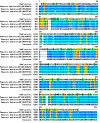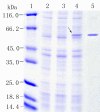Identification and characterization of a novel fumarase gene by metagenome expression cloning from marine microorganisms
- PMID: 21092234
- PMCID: PMC3002918
- DOI: 10.1186/1475-2859-9-91
Identification and characterization of a novel fumarase gene by metagenome expression cloning from marine microorganisms
Abstract
Background: Fumarase catalyzes the reversible hydration of fumarate to L-malate and is a key enzyme in the tricarboxylic acid (TCA) cycle and in amino acid metabolism. Fumarase is also used for the industrial production of L-malate from the substrate fumarate. Thermostable and high-activity fumarases from organisms that inhabit extreme environments may have great potential in industry, biotechnology, and basic research. The marine environment is highly complex and considered one of the main reservoirs of microbial diversity on the planet. However, most of the microorganisms are inaccessible in nature and are not easily cultivated in the laboratory. Metagenomic approaches provide a powerful tool to isolate and identify enzymes with novel biocatalytic activities for various biotechnological applications.
Results: A plasmid metagenomic library was constructed from uncultivated marine microorganisms within marine water samples. Through sequence-based screening of the DNA library, a gene encoding a novel fumarase (named FumF) was isolated. Amino acid sequence analysis revealed that the FumF protein shared the greatest homology with Class II fumarate hydratases from Bacteroides sp. 2_1_33B and Parabacteroides distasonis ATCC 8503 (26% identical and 43% similar). The putative fumarase gene was subcloned into pETBlue-2 vector and expressed in E. coli BL21(DE3)pLysS. The recombinant protein was purified to homogeneity. Functional characterization by high performance liquid chromatography confirmed that the recombinant FumF protein catalyzed the hydration of fumarate to form L-malate. The maximum activity for FumF protein occurred at pH 8.5 and 55°C in 5 mM Mg(2+). The enzyme showed higher affinity and catalytic efficiency under optimal reaction conditions: K(m) = 0.48 mM, V(max) = 827 μM/min/mg, and k(cat)/K(m) = 1900 mM/s.
Conclusions: We isolated a novel fumarase gene, fumF, from a sequence-based screen of a plasmid metagenomic library from uncultivated marine microorganisms. The properties of FumF protein may be ideal for the industrial production of L-malate under higher temperature conditions. The identification of FumF underscores the potential of marine metagenome screening for novel biomolecules.
Figures






Similar articles
-
Identification of a novel fumarase C from Streptomyces lividans TK54 as a good candidate for L-malate production.Mol Biol Rep. 2014 Jan;41(1):497-504. doi: 10.1007/s11033-013-2885-8. Epub 2013 Dec 5. Mol Biol Rep. 2014. PMID: 24307253
-
Expression of a metagenome-derived fumarate reductase from marine microorganisms and its characterization.Folia Microbiol (Praha). 2013 Nov;58(6):663-71. doi: 10.1007/s12223-013-0256-4. Epub 2013 May 11. Folia Microbiol (Praha). 2013. PMID: 23666779
-
MmcBC in Pelotomaculum thermopropionicum represents a novel group of prokaryotic fumarases.FEMS Microbiol Lett. 2007 May;270(2):207-13. doi: 10.1111/j.1574-6968.2007.00665.x. Epub 2007 Feb 22. FEMS Microbiol Lett. 2007. PMID: 17319878
-
Biochemical Characterization of Two Clinically-Relevant Human Fumarase Variants Defective for Oligomerization.Open Biochem J. 2018 Jan 29;12:1-15. doi: 10.2174/1874091X01812010001. eCollection 2018. Open Biochem J. 2018. PMID: 29456767 Free PMC article. Review.
-
Fumarate and its downstream signalling pathways in the cardiorenal system: Recent insights and novel expositions in the etiology of hypertension.Eur J Pharmacol. 2023 Dec 15;961:176186. doi: 10.1016/j.ejphar.2023.176186. Epub 2023 Nov 8. Eur J Pharmacol. 2023. PMID: 37944846 Free PMC article. Review.
Cited by
-
Active inclusion bodies of acid phosphatase PhoC: aggregation induced by GFP fusion and activities modulated by linker flexibility.Microb Cell Fact. 2013 Mar 14;12:25. doi: 10.1186/1475-2859-12-25. Microb Cell Fact. 2013. PMID: 23497261 Free PMC article.
-
Applications of Marine-Derived Microorganisms and Their Enzymes in Biocatalysis and Biotransformation, the Underexplored Potentials.Front Microbiol. 2019 Aug 20;10:1453. doi: 10.3389/fmicb.2019.01453. eCollection 2019. Front Microbiol. 2019. PMID: 31481935 Free PMC article. Review.
-
Emerging strategies and integrated systems microbiology technologies for biodiscovery of marine bioactive compounds.Mar Drugs. 2014 Jun 10;12(6):3516-59. doi: 10.3390/md12063516. Mar Drugs. 2014. PMID: 24918453 Free PMC article. Review.
-
Identification of a novel fumarase C from Streptomyces lividans TK54 as a good candidate for L-malate production.Mol Biol Rep. 2014 Jan;41(1):497-504. doi: 10.1007/s11033-013-2885-8. Epub 2013 Dec 5. Mol Biol Rep. 2014. PMID: 24307253
-
Characterization of a novel serine protease inhibitor gene from a marine metagenome.Mar Drugs. 2011;9(9):1487-1501. doi: 10.3390/md9091487. Epub 2011 Sep 5. Mar Drugs. 2011. PMID: 22131953 Free PMC article.
References
Publication types
MeSH terms
Substances
Associated data
- Actions
LinkOut - more resources
Full Text Sources
Molecular Biology Databases
Miscellaneous

